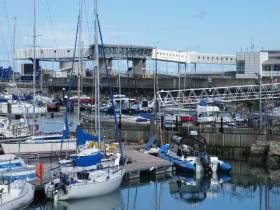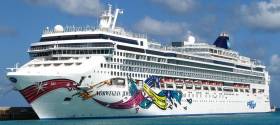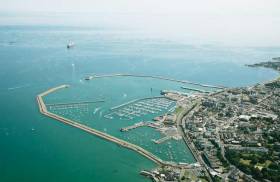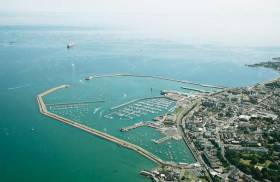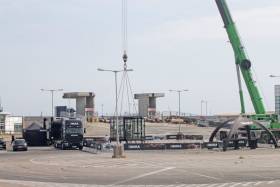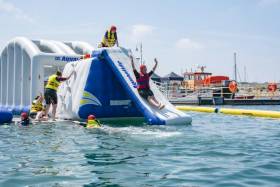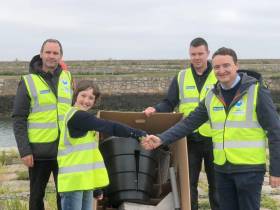Displaying items by tag: Dun Laoghaire Harbour
Harbour Company ‘A Gift and A Jewel’ for Dun Laoghaire Locals
#DLharbour - People in Dún Laoghaire Rathdown are getting “a gift and a jewel” in the transfer of the Dún Laoghaire Harbour company to the county council, Minister for Transport Shane Ross has insisted.
As The Irish Times reports, the Minister confirmed that he had on Wednesday formally signed the transfer of the harbour company’s functions to the county council.
Mr Ross rejected claims that the company had €33 million in liabilities and insisted it was closer to €10 million which would extend over a long period of time for repairs and maintenance.
He stressed that it will not affect local property tax or local projects and the transfer included a “seven-digit cash reserve”.
The Minister was speaking during a heated Seanad debate on the company’s transfer.
“It’s a gift and a jewel being given to the people of Dún Laoghaire Rathdown,” he said. “This is a great deal for the citizens and residents.”
For more the newspaper reports here in addition Afloat this week revealed a cruiseship from Norwegian Cruise Line is to call during the 2019 season totalling six calls.
Harbour Transfer ‘A Kick In The Teeth’ To Dun Laoghaire Residents, Council Session Hears
#DLHarbour - Councillors in Dun Laoghaire-Rathdown have expressed anger and frustration over the transfer of Dun Laoghaire Harbour Company’s multi-million liabilities to the local authority.
Transport Minister Shane Ross was in the Seanad this afternoon for statements on the transfer of functions of the harbour company to Dun Laoghaire-Rathdown County Council (DLRCoCo), which was made formal today (Wednesday 3 October) after he signed off on the move last week.
DLRCoCo later held a Special Meeting to debate the transfer, at which Councillor Cormac Devlin said the debt “will have a significant impact on future council budgets and may lead to reduced services and increases in commercial rates and the Local Property Tax.
“The chief executive of the council confirmed to members that the figure of €33m may actually be at the lower end of the scale of liabilities. This directly contradicts Minister Shane Ross’ claim to the Seanad that the debt is only €10m.”
Cllr Devlin called on the Government to “find a way to indemnify the council to ensure residents and business owners do not suffer for their policies.”
Councillor Dónal Smith was even more vociferous, branding Minister Ross’ lack of a promise of indemnity as “a kick in the teeth for the people who elected him. He has hung a financial albatross around the necks of his constituents. He will not be thanked.”
Cllr Smith said suggestions that the council sell public lands earmarked for housing to pay down the harbour’s debts amount to “a scandal”.
“If Fine Gael gives a toss about the residents and ratepayers of Dún Laoghaire-Rathdown, their Government will indemnify the council,” he added.
Update on Thursday 4 October: The full Special Meeting can be streamed in full from DLRCoCo's webcast player HERE.
Norwegian to Bring 'Jewel' As Part of Dun Laoghaire Harbour's Doubling of Cruise Calls in 2019
#CruiseLiners - Afloat can reveal Dun Laoghaire Harbour's cruiseship caller list in season 2019 is scheduled to be as twice as busy compared to this year's total of just three calls, writes Jehan Ashmore.
In what will also make next season different, asides doubling cruise calls to six, is the return of an anchorage caller offshore of the port, in this case the giant Norwegian Jewel. This is due to the cruiseship's deep draft that cannot be accommodated inside the south Dublin Bay harbour.
The cruiseship will be a boost to the local economy as the 2,300 passenger capacity vessel is to make a debut in June and a second call the following month. The season's other four cruise calls however accounts overall for less than the total of 8 calls achieved in 2017.
At almost 100,000 gross tonnage, the Norwegian Cruise Line operated vessel is the leadship of the cruiseship's namesake 'Jewel' class completed in 2005. A refurbishment took place four years ago.
The call of the NCL ship is new in the context of the concerted effort by Dun Loaghaire Harbour Company in recent years to bring back cruiseships that began in 2011. However, NCL did deploy Norway, the distinctive twin funnelled (former classic liner, France) which was recalled with much personal interest when two offshore calls took place during the 1990's. The anchorage visit was also noted given the use of the cruiseship's pair of particulary large tender craft that were lowered by cranes from the fo'c'sle i.e. in front of the bridge above the bow.
As for the Norwegian Jewel's tenders they will too have to shuttle back and forth from the near 300m long ship in stark contrast to this season when a pair of much smaller sized ships arrived within the harbour. Star Pride and slightly larger capacity sister, Star Breeze, just shy of 10,000 tonnes and 133m in length docked at Carlisle Pier with around 200 passengers.
The Windstar Cruises operated pair of mega-yacht luxury boutique style cruiseships will return to Dun Laoghaire Harbour in 2019. Star Pride with a crew of around 150, launches the season again with a call in June and is to be repeated following the debut call of Norwegian Jewel. Whereas, Star Breeze is to make an appearance likewise of this year, with two successive visits in the month of September.
Community Projects ‘In Jeopardy’ As Local Authority Takes On Dun Laoghaire Harbour Debts
#DLHarbour - Dun Laoghaire-Rathdown county councillors have suggested a potential increase in Local Property Tax to help offset Dun Laoghaire Harbour Company’s multi-million-euro liabilities, now that the harbour has been officially transferred to local authority control.
Cllr Barry Ward tweeted late last night (Wednesday 26 September) that Transport Minister Shane Ross had signed over responsibility for Dun Laoghaire Harbour “with no financial provision for the estimated €33.5 million debt now imposed on his own constituents, despite repeated calls for fairness from councillors.
“[Dun Laoghaire-Rathdown] cannot sustain this level of financial liability,” he added.
Minister @Shane_RossTD has tonight signed @DLHarbour over to @dlrcc with no financial provision for the estimated €33.5 million debt now imposed on his own constituents, despite repeated calls for fairness from councillors. DLR cannot sustain this level of financial liability. pic.twitter.com/DYENREpcv8
— Barry Ward (@barrymward) September 26, 2018
A slew of projects and developments in the Dun Laoghaire-Rathdown area — from Stillorgan Library to Glenalbyn Swimming Pool to the Marlay Park Masterplan — are now “all in jeopardy”, according to local councillor Barry Saul.
Glenalbyn Pool , Stillorgan Library , Marley running track , Fernhill Phase 2, Marley Park Masterplan all in jeopardy following Minister Ross decision to sign over DL Harbour and 33 million liabilities to Dun Laoghaire Rathdown Council pic.twitter.com/H1DDwI5J9E
— Barry Saul (@cllrbarrysaul) September 26, 2018
Cllr Lynsey McGovern added that “we can kiss goodbye to keeping commercial rates and property tax down now,” while Cllr Jim Gildea said even a 30% increase in LPT “would only give us €15m. I for one couldn’t vote to hoist that burden on our householders”.
Minister Ross confirmed back in April this year that “all assets and liabilities” of Dun Laoghaire Harbour Company would transfer to the local authority upon the former’s dissolution — and made clear that National Ports Policy does not provide for Exchequer funding “for any port company”.
The transfer of liabilities was branded as “unacceptable” at the time by local Green Party councillor Ossian Smyth.
Independent Senator Victor Boyhan was set to raise the issue of the harbour transfer and its financial implications for DLRCoCo in the Seanad this morning, as previously reported on Afloat.ie.
Update Friday 28 September: Cllr Barry Ward tweeted confirmation that Dun Laoghaire Harbour will come under control of Dun Laoghaire-Rathdown County Council next Wednesday 3 October.
Fine Gael councillors have called for a special meeting on the issue on the same day at 5pm. An invitation will be extended to Transport Minister Shane Ross.
The transfer order for @DLHarbour has been signed by Minister @Shane_RossTD. #DúnLaoghaire #Harbour will now come under the controll of @dlrcc on Wednesday next, 3 October. The Council was informed by letter yesterday. pic.twitter.com/SwGC9LLJ6c
— Barry Ward (@barrymward) September 28, 2018
Independent Senator to Raise Dun Laoghaire Harbour in Seanad This Morning
The transfer of Dun Laoghaire Harbour Company to Dún Laoghaire Rathdown County Council will be raised by Independent Senator Victor Boyhan in the Seanad today at 11am.
Boyhan who previously expressed doubts about the corporate governance of the Harbour Company is expected to claim this morning that there are serious financial implications for DLR County Council and its revenue and capital funding streams that need to be resolved in advance of the Government completing a formal transfer.
Listen live here
Dun Laoghaire Harbour Transfer In Final Stages
#DLHarbour - Dun Laoghaire County Council is currently involved in final negotiations over the takeover of Dun Laoghaire Harbour.
In his response to a Dáil question on the timeline for transfer of the port to the local authority, Transport Minister Shane Ross confirmed that the order of transfer was sent to the Department of Housing, Planning and Local Government in mid July.
This followed issues relating to risk assessment that were “clarified at meetings that took place between the relevant officials” in the council and harbour company executive since March.
Local residents in Dun Laoghaire also met over the summer to establish any “common concerns” that may be presented to the harbour’s new overseers.
Afloat.ie understands that the final negotiations are centring on the harbour company's liabilities, which local Green Party councillor Ossian Smyth branded as “unacceptable” in April this year.
‘Dining In The Sky’ Comes To Dun Laoghaire This Week
#DunLaoghaire - Preparations are under way in Dun Laoghaire Harbour for a special ‘dining in the sky’ experience this week.
After visits to Portugal, Italy and Germany, the latest stop on the BORA Revolution Tour will see the German cooking systems specialists demonstrate their latest technology in a glass box hoisted 30 metres above Dun Laoghaire by crane from today Thursday 5 till Saturday 7 July.
Those select few lucky enough to partake in the experience will be treated to food prepared by Ballymaloe-trained Ruth Wassel as they enjoy a stunning panorama of the south city and Dublin Bay.
And as our photos show, the event certainly promises new heights in dining!
 A different angle shows the full extent of the heights diners will reach
A different angle shows the full extent of the heights diners will reach
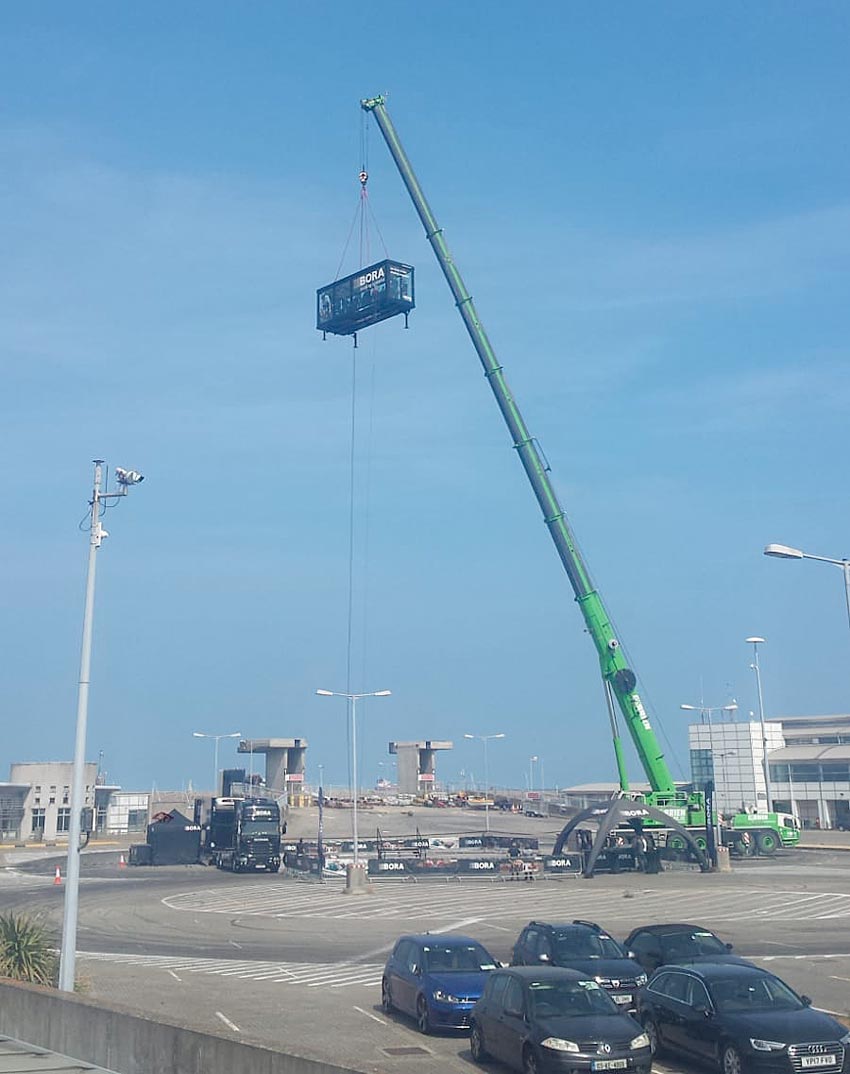
Harbour Splash is the name of Dublin’s first inflatable aqua park, which will open to the public later this week in Dún Laoghaire Harbour.
An obstacle course over water including trampolines, climbing frames, slides, monkey bars and more will be this summer’s newest attraction at Coal Harbour.
Colin Harris, director of Big Splash Water Parks, the company behind the venture, is expecting people of all ages to come and enjoy an action packed time on the water.
“Children as young as eight can participate and we believe Harbour Splash will be the most fun you can have on the water for birthday parties, hen and stag dos, corporate events and of course it will make a brilliant family day out,” Harris said.
The aqua park’s grand opening will be this Saturday 7 July with the online booking system already live. One-hour sessions are priced at €18 for under 18s and €22 for adults. Discounts are available for groups of 15 or more.
Dun Laoghaire Harbour Company chief executive Gerry Dunne said: “Harbour Splash is a welcome addition to the harbour as it allows families and children public access to the water in a new fun way.”
Flossie Welcomes First Seabin For Dun Laoghaire Harbour
#Seabin - Young coastal litter crusader Flossie Donnelly is celebrating the installation of Dun Laoghaire Harbour’s first Seabin after a successful fundraising campaign.
The 11-year-old was on hand at noon today (Tuesday 22 May) to see the first of two such devices submerged into the harbour’s waters, where they will quietly trap floating debris on the surface that has become the scourge of regular harbour users.
As previously reported on Afloat.ie, a single Seabin has the potential to collect as many as 83,000 plastic bags or 20,000 plastic bottles every year.
Enterprising Flossie has been campaigning for a cleaner Dun Laoghaire and Dublin Bay since last year, when she began her regular beach cleaning meet-ups in Sandycove.
“When Flossie first approached us, she already knew what she wanted, to install Ireland’s first Seabin and was well underway with her fundraising efforts,” said Dun Laoghaire Harbour Company operations manager Tim Daly. “Her resolve inspired us to whatever we could to help her out.”
Seabin distributor Inland and Coastal Marina Systems also expressed their delight to be a part of the project with Flossie, who will be grand marshall of the first March for the Ocean in Dun Laoghaire on Saturday 9 June.
Councillors on Dún Laoghaire-Rathdown County Council have unanimously agreed to send a highly critical letter to Minister for Transport, Tourism and Sport, taking him to task over his attitude to the transfer of Dún Laoghaire harbour to the Council.
Download the letter below
Legislation from 2015 envisages that the historic harbour will soon come under the control of Dún Laoghaire-Rathdown County Council, but in March, councillors were stunned to learn that independent risk assessors estimate the cost of repairs to the harbour could be €33.5 million.
Councillors are now faced with a huge financial burden that they say will massively compromise the Council’s ability to deliver services locally, and in the Minister’s own constituency, and could cause significant increases in local property tax and/or commercial rates.
"The letter says that the Minister's decision to transfer the harbour, without any funding “would constitute an act of vandalism”.
Proposed by the Fine Gael Group Leader, Councillor Barry Ward, the letter to Minister Ross says that “such a move will mean your own constituents will see reductions in the Council’s provision of public facilities such as parks, libraries, sports pitches, road, footpaths, lighting, and a range of other things that we currently provide for the businesses and resident of Dún Laoghaire-Rathdown.”
In a stark statement of the Council’s concerns, the letter says that the Minister's decision to transfer the harbour, without any funding “would constitute an act of vandalism”.
They remind the Minister that his proposal “will hurt the very people you represent, your own constituents”.
The elected members of the Council have asked for the Minister to behave in “a fair and consistent manner” and have now called on him to indemnify the Council against the cost of taking over the harbour, for a period of seven years.


























